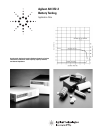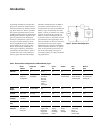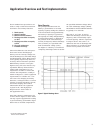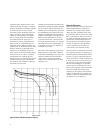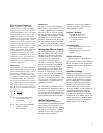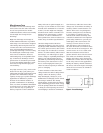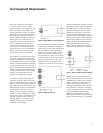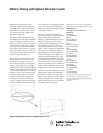
5
Effective Internal Impedance
Battery impedance is dependent
on temperature, its state of charge,
and the load frequency. The effective
internal impedance is lower for a fully
charged battery than it is for a dis-
charged one. Having a low internal
resistance is very important when the
battery must support a high current
for a short time. Low temperature, use,
and long storage periods all increase
a battery’s internal resistance. Nickel-
cadmium batteries also have a high
effective capacitance. Their total effec-
tive impedance is so low that, in
applications where they are continu-
ously being “trickel-charged” at rates
from 0.01C to 0.1C, they make excel-
lent ripple filters. Resistance and
impedance tests are explained in the
following paragraphs.
Resistance Test
The battery must be fully charged as
outlined above. Batteries rated 5 Ah or
less are discharged at 10C for 2 min-
utes and then switched to 1C. The
battery voltage is recorded just prior
to switching and again upon reaching
its maximum value after switching.
All voltage measurements are made at
the terminals of the battery independ-
ently of the contacts used to carry
current. The effective internal resist-
ance (R
e
) is then calculated as follows:
R
e
=
∆V
=
V
L–
V
H
∆
I =
I
H–
I
L
I
H,
V
H = the current and voltage,
recorded just prior
to switching
I
L,
V
L = the current and maximum
voltage, recorded
after switching
Impedance Test
The battery must be fully charged as
outlined above. An AC current source
(
~
1 kHz) is applied to the terminals of
the battery. The AC current through
the battery and the voltage across it
are measured. The impedance is simply
calculated as V/I. An interesting
alternative testing method that yields
the same result is to place a varying
(
~
1 kHz) load across the fully charged
battery instead of the AC power source.
Discharge Rate Effect on Capacity
The rate of discharge has an effect on
the total capacity of a battery. Heavy
discharge rates decrease the total
available capacity of a battery. The
test is done at two temperatures:
–20 degrees C and 23 degrees C.
The battery is first fully charged at
23 degrees C and then immediately
stored for 24 hours at an ambient
temperature of –20 degrees C. It is
then discharged at an ambient tem-
perature of –20 degrees C at a con-
stant current rate of 1C to an EODV
of 0.8 volts. Then the procedure is
repeated at discharge rates of 5C and
C/5. The whole test is then repeated
at a temperature of 23 degrees C to
an EODV of 0.9 volts.
For each of the six discharge cycles,
the manufacturer supplies the value of
capacity to be expected as a percent of
C1. Charging and discharging at tem-
peratures below the specification sheet
recommendation should be avoided.
Life Cycle Performance
Life cycle testing is a measure of
expected battery performance in actual
service. Life cycle performance is
characterized by dynamically loading
the battery in a simulated “real-life”
situation for 50 or more charge and
discharge cycles as follows:
The battery is given five stabilizing
cycles in accordance with the previ-
ously outlined procedure.
Life Cycles 1 through 48
1. Charge 11 hours and
20 minutes at C/10
2. Discharge immediately at
1C for 40 minutes
3. No rest
Life cycles 49 and 50
1. Charge for 20 hours at C/10
2. Rest 2 to 4 hours
3. Discharge at 1C to 0.9 volts
EODV
Repetition of Life Cycles
Repeat cycles 1 to 50 as desired.
The capacity at cycle 50, and multiples
thereof, should be no lower than that
stated for this procedure by the man-
ufacturer.
Extended Overcharge
The ability of a battery to withstand
overcharge is determined by charging
the battery at a constant current of
C/10, or at the maximum overcharge
rate recommended by the manufac-
turer, at an ambient temperature of
23 degrees C for 6 months. The bat-
tery should at no time show either
electrolyte leakage or visual evidence
of distortion beyond the standard
maximum dimensions for that bat-
tery. When discharged at a constant
current of 1C to an EODV of 0.9V, the
battery should have a capacity equal
to or greater than the extended over-
charge capacity specification.



